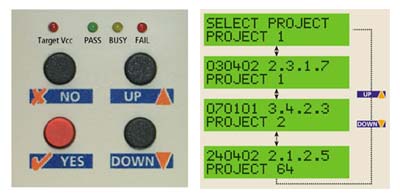|
|
|
 |
Main Features |
|
-
High-speed In-System Programming (ISP) support of NXP LPCxxxx microcontrollers
-
Programming solutions for development, low / mid / high volume production and field programming of NXP LPCxxxx microcontrollers
-
Programs the on-chip FLASH Memory of NXP LPCxxxx microcontrollers
-
Uses industry standard ‘ARM JTAG Debug Interface’ port as the ISP interface
-
Very high-speed programming due to fast JTAG programming interface, local user data storage and optimised programming algorithms
-
Programmers can be used in ‘Standalone Mode’ (no PC required)
-
Supports high-speed program / verify of the on-chip FLASH in a singe operation.
-
Optimised Erase operations - blanks the on-chip FLASH in less than 200ms
-
Supports programming of NXP LPCxxxx devices when placed in a ‘JTAG Chain’ (JTAG daisy-chain mode)
-
Fully user-configurable pre-programming statemachine supports custom target reset circuits
|
 |
Development programming mode |
|
-
Powerful yet simple-to-use Development Suite called ‘EDS’
-
All aspects of programming the NXP LPCxxxx device can be controlled from EDS (Equinox Development Suite)
-
Program and read back the LPC device on-chip FLASH memory under PC control
-
All projects can be developed and tested on a real device before uploading a ‘Standalone Programming Project’ to the programmer
-
Tested ‘Programming Projects’ can then be uploaded to the programmer for use in ‘Standalone Mode’
Please note:
This is a 'programming solution' only. It is not a debugger.
|
 |
Production Programming solutions |
|
|

-
Programmers can be used in ‘Standalone Mode’ (no PC required)
-
A single ‘Standalone Programming Project’ can Erase the device and program /verify the FLASH area in a single operation.
-
Up to 64 x NXP LPCxxxx ‘Standalone Programming Projects’ can be stored inside the programmers supported.
-
Programmer can store multiple versions of firmware for different ‘customer product versions’.
-
Support for programming unique data per device including serial numbers, MAC addresses, calibration data, barcode data etc.
-
ConsoleEDS – powerful ‘console application’ allows the programmer to be controlled from any custom remote application.
-
ISP-PRO – powerful production control / sequencing utility supports controlling of up to 32 programmers from the same PC.
-
ISPnano-MUX programmer family - supports sequential programming of up to 8 x independent Target Boards (UUTs) on a ‘PCB Panel’
-
ISPnano-GANG programmer family - supports concurrent gang programming of up to 32 x independent Target Boards (UUTs) on a ‘PCB Panel’
|
 |
Field Programming solutions |
|
|

-
The ISPjuno programmer can be used to re-program an NXP LPCxxxx microcontroller based Target System in the field (coming soon - please enquire for further details)
-
All programmer operates in so-called ‘Standalone Mode’ where a PC / laptop is not required after the programmer has been configured.
-
Operator uses programmer keypad / Display to select the required ‘Standalone Programming Project’ to execute
-
Single-key ‘Autoprogram button’ – allows the same project to be executed repeatedly
-
Ideal for field-service personnel for re-programming vending machines and any other equipment / plant in the field.
-
The ISPjuno programmer can store up to 64 x ‘Standalone Programming Projects’ so the field operator can select which product firmware to program.
|
 |
LPC NXPxxxx - ISP Connections |
|
|

Important note:
The programmer connects to the 'JTAG Debug port' of the NXP LPCxxxx microcontroller.
|
 |
ARM ISP Connector Cables for portable programmers |
|
|

A special 'ARM ISP cable' has been developed which connects between any Equinox portable ISP programmer e.g. Epsilon5, FS2003, FS2009 and any NXP LPC2xxx based Target System.
|
 |
NXP LPX2xxx - Device Support List |
|
|
The following NXP LPCxxxx FLASH microcontrollers devices are currently supported by our range of development, field and production ISP programmers:
| NXP (Philips) |
| |
| JTAG - In System Programming (ISP) via JTAG Debug Port: |
| NXP (Philips) LPCxxxx (ARM7) Microcontroller Family: |
|
LPC2101FBD48, LPC2102FBD48, LPC2103, LPC2103FBD48, LPC2131FBD64, LPC2131FBD64/01, LPC2132FBD64, LPC2132FHN64, LPC2132FHN64, LPC2132FHN64/01, LPC2134FBD64, LPC2134FBD64/01, LPC2136FBD64, LPC2138, LPC2138FBD64, LPC2138FBD64/01, LPC2148, LPC1766 - new |
Important note:
The only programming interface currently supported is the 'JTAG debug port' of the LPC device. We do not currently support the LPC 'UART Boot Loader Mode' via the LPC UART pins. The JTAG interface yields much faster programming than the 'UART Boot Loader Mode'.
|
 |
Equinox programmers supporting NXP LPCxxxx microcontrollers |
|
|
Equinox offer a comprehensive range of programmers which support development, field and production programming of NXP LPCxxxx FLASH microcontroller devices.
The table below details the available programmer support:
|
Programmer |
NXP LPC2xxx Support Requirements |
Upgrade Order Code |
|
|
|
|
|
|
License upgrade
|
|
|
FS2003(UN) |
License upgrade
+ CAB-ARM7-20W ISP Cable |
FS2003-UPG27 |
|
FS2009(UN) |
License upgrade
+ CAB-ARM7-20W ISP Cable |
FS2009-UPG27 |
|
PPM3-MK2 |
License upgrade
+ EQ-IO-CON-10 Connector Module
+ EQ-SFM-MAX-V1.3 High-speed I/O Driver Module |
PPM3A1-UPG27 |
|
PPM4-MK1 |
License upgrade
+ EQ-IO-CON-10 Connector Module
+ EQ-SFM-MAX-V1.3 High-speed I/O Driver Module |
PPM4MK1-UPG27 |
|
ISPnano Series 1 |
License upgrade |
ISPNano-UPG27 |
|
ISPnano Series 2 |
License upgrade |
ISPNano-UPG27 |
|
ISPnano Series 3 |
License upgrade |
ISPNano-UPG27 |
|
ISPnano Series 3 ATE |
License upgrade |
ISPNano-UPG27 |
|
ISPnano Series 4 |
License upgrade |
ISPNano-UPG27 |
|
ISPnano-MUX8 |
License upgrade |
ISPNano-UPG27 |
|
ISPnano-MUX4 |
License upgrade |
ISPNano-UPG27 |
|
ISPnano-MUX2 |
License upgrade |
ISPNano-UPG27 |
|
|
|
|
Please note:
- A chargeable ‘License Upgrade’ is required to enable the NXP LPCxxxx support on any of these programmers.
- A suitable ‘NXP LPCxXXX ISP Connector Cable’ is also required to connect from the programmer to the NXP LPCxxxx Target Board. This is provided with the License Upgrade.
|
| |